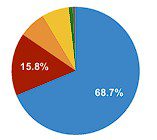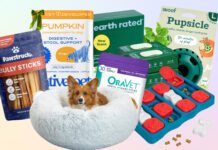Providing a balanced, home-cooked diet for your dog doesn’t have to be complicated! This simple yet nutritionally complete beef and brown rice recipe follows NRC guidelines for adult maintenance and uses ingredients readily available at most supermarkets. Whether you’re new to homemade dog food or looking for a convenient, balanced recipe, this guide will walk you through the ingredients, preparation, and nutritional benefits of feeding fresh, cooked meals to you dog.
Let’s get started!
NOTE: When made as specified, this recipe provides a nutritionally complete diet for healthy adult dogs. Adding, removing, or changing ingredients is not recommended as it will affect the nutritional balance of the food. This recipe is not suitable for dogs with medical conditions that require specialized diets.
Ingredients
The goal of this formula is to provide you with a recipe that you can easily cook in your kitchen with readily available ingredients your dog will love. This single protein, grain inclusive recipe is made with human grade ingredients you shouldn’t need to search hard for including:
- Ground Beef, 90% lean, 10% fat
- Beef Heart
- Beef Liver
- Brown Rice
- Pumpkin, canned, without added salt or sugar
- Green Beans
- Apples
In today’s fast paced world, expecting anyone to prepare their dog’s meal every day is impractical. With this recipe, you can cook it in bulk, and it can be stored for up to 4 days in the refrigerator or frozen. While the food can technically be frozen indefinitely, we recommend using it within 6 months since it will lose nutrients over time.
Single protein recipes reduce the number of ingredients needed to prepare dog food at home. This one uses beef since it is the most common and easily accessible red meat protein that can be used to cook dog food. Because the organs are nutrient dense and are often sold for human consumption, ingredients such as beef heart and beef liver are typically available throughout the U.S. and are beneficial for creating a balanced, single protein diet for dogs.
Cooking increases the palatability of foods which makes this recipe beginner friendly. In addition, it’s an excellent way to entice the pickiest of eaters to consistently eat a balanced diet when other foods have failed. However, if you are concerned about your dog eating the rice we can let you in on a little secret. Replace the water with homemade bone broth when cooking the rice to increase its palatability.
Supplements
Accessibility limits our ability to utilize certain whole foods when creating a balanced diet for our dogs. Furthermore, using only whole foods increases the complexity of recipes which ultimately is not convenient for buy lifestyles. Therefor this recipe requires the supplements listed below to ensure it provides all the essential nutrients needed for optimal canine health.
| Supplement | Nutrient(s) Provided | |
|---|---|---|
| NOW Cod Liver Oil | EPA+DHA fatty acids, Vitamin D | |
| Hempseed Oil | ALA fatty acids | |
| Animal Essentials | Calcium, Magnesium, Iodine | |
| Nutritional Yeast | B Vitamin Complex | |
| Solgar Chelated Manganese | Manganese | |
| NOW Foods E-Oil | Vitamin E | |
| NOW Foods Pure Kelp Powder | Iodine | |
The removal of any supplement will negatively impact the nutritional balance of the recipe. |
||
Culinary Closure
Don’t miss your opportunity to provide your dog with a home prepared diet made with human-grade ingredients that are easily accessible in supermarkets! This cooked beef and brown rice recipe is balanced for adult maintenance and is a gateway into home prepared diets, using accessible and limited ingredients to ensure a diet that provides convenience without sacrificing nutrition.
Your dog will thank you!
Cooking Instructions for a 60 Pound, Inactive Dog
For an in-depth review of ingredient amounts for other weights and activity levels see below.
Ingredients for this recipe can be prepared in any order. Neither the canned pumpkin nor the apple should be cooked.
Beef & Brown Rice Batch Calculations
| Below are the calculations to feed an inactive 60 pound dog for 7 days. This recipe can be prepared in batch increments versus preparing meals daily. Store up to 4 days of prepared food in the refrigerator and store the remaining food in the freezer to prevent food spoilage. Frozen food can be stored indefinitely but it will lose nutrients over time. Therefore, it is recommended to feed all food within 6 months of freezing. | ||
|---|---|---|
Recipe Terms Defined |
||
| Meal Prep Recipe Ingredients | Food ingredients required to prep the recipe. | |
| Nutritional Supplements Added Daily | Supplements that must be added to food daily. | |
| Batch Prep Nutritional Supplements | Supplements that can be batch prepared into food. | |
Cooked & Raw Ingredient Weights |
||
| Meal Prep Recipe Ingredients | Cooked Weights | Raw Weights |
| Ground Beef, 90% lean, 10% fat, cooked | 4.43 LB | 5.53 LB |
| Beef Heart, cooked | 0.93 LB | 1.16 LB |
| Beef Liver, cooked | 0.23 LB | 1.16 LB |
| Brown Rice, cooked | 2.01 LB | 0.70 LB |
| Pumpkin, canned without added salt or sugar | 1.08 LB | |
| Green Beans, cooked | 0.62 LB | 1.31 LB |
| Apples, with peeling, raw, chopped | 0.46 LB | |
| 8.21 LB | 10.56 LB | |
Nutritional Supplements Added Daily |
||
| NOW Cod Liver Oil | 650 mg | 7.00 PIll |
| Hempseed Oil | 7.00 TSP | |
| NOW E Oil | 31.26 IU/drop | 21.0 DROP |
Batch Prep Nutritional Supplements |
||
| Animal Essentials Seaweed Calcium | 7.0 TSP | |
| Nutritional Yeast | 3.5 TSP | |
| Solgar Chelated Manganese | 8 mg | 1.75 Pill |
| NOW Pure Kelp Powder | 450 mcg/scoop | 3.5 SCOOP |
Supplement Calculations
| The calculations below are the supplement dosages that are required per 1 pound of the Beef & Brown Rice recipe. These calculations are needed when feeding more or less food based on weight and activity. | |||
|---|---|---|---|
Nutritional Supplements Added Daily Needed Per Pound of the Recipe | Batch Prep Nutritional Supplements Needed Per Pound of the Recipe |
||
| NOW Cod Liver Oil 650 mg | 0.75 PILL | Animal Essentials Seaweed Calcium | 0.75 TSP |
| Hempseed Oil | 0.75 TSP | Nutritional Yeast | 0.25 TSP |
| Now E Oil 31.26 UI/Drop | 2.25 Drop | Solgar Chelated Manganese, 8 mg | 0.25 PILL |
NOW Pure Kelp Powder, 450 mcg/scoop | 0.33 SCOOP | ||
Why are there cooked and raw weights listed?
The recipe is formulated using cooked ingredients. Due to moisture loss that occurs in the cooking process, there is a weight reduction when raw ingredients are cooked. Therefore additional calculations are provided to assist in identifying how much of each raw ingredient is required to prepare the recipe at home.
Are the supplements in the recipes necessary and safe?
All supplements listed in the recipe are required and should not be eliminated. The supplements listed are from human grade brands that operate in an FDA certified facility and are GMP certified. These brands perform third party purity tests and provide the nutritional analysis on their supplements. This criteria is important in ensuring that the supplement is of high quality and provides the nutrients required for the recipes. Each supplement dosage has been calculated to ensure they provide the essential nutrients required for optimal health without exceeding Safe Upper Limits (this avoids toxicity). Removing the supplements listed in the recipe should be avoided as it will result in nutritional deficiencies.
PREPARATION INSTRUCTIONS
To Prepare Ground Beef, Beef Heart, and Beef Liver:
All beef ingredients should be cooked to an internal temperature of 160°F (the minimum safe internal temperature for beef proteins). As cooking times can vary significantly, we strongly recommend using a meat thermometer to ensure animal proteins are cooked to a safe temperature.
Cooking times will depend on the method used and amount of each ingredient being cooked. For example, cooking 5.5 pounds of ground beef to 160°F typically takes 35-40 minutes in an oven preheated to 400°F. If using a pressure cooker it generally takes around 20 minutes for 5.5 pounds of ground beef to reach 160°F.
The beef heart and beef liver should be chopped into bite-sized pieces once cooked and cooled.
To Prepare Brown Rice:
Cook brown rice in water on stove or in rice cooker according to package instructions.
To Prepare Green Beans:
Boil or steam green beans until tender, approximately 5-7 minutes.
To Prepare Apple (raw)
Peel raw apples and chop into bite-sized pieces.
All cooked ingredients should be cooled to room temperature. Once everything has cooled, all ingredients should be mixed thoroughly along with the Animal Essentials Seaweed Calcium, Nutritional Yeast, Solgar Chelated Manganese, and NOW Pure Kelp Powder Supplements. The three remaining supplements—Cod liver oil, hempseed oil, and E-Oil—should be added to daily meals.
Beef & Brown Rice
| Recipe | Amount | Calories | |
|---|---|---|---|
| Ground Beef, 90% lean, 10% fat, cooked | 10.12 OZ | 287 G | 623 KCAL |
| Beef Heart cooked | 2.12 OZ | 60 G | 99 KCAL |
| Beef Liver, cooked | 0.53 OZ | 15 G | 29 KCAL |
| Brown Rice, cooked | 4.58 OZ | 130 G | 144 KCAL |
| Pumpkin, canned, without added salt or sugar | 2.47 OZ | 70 G | 24 KCAL |
| Green Beans, cooked | 1.41 OZ | 40 G | 14 KCAL |
| Apples, with peeling, raw, chopped | 1.06 OZ | 30 G | 16 KCAL |
| NOW Cod Liver Oil, 650 mg | 1.00 PILL | 1 PILL | 5 KCAL |
| Hempseed Oil | 1.00 TSP | 5 G | 43 KCAL |
| Animal Essentials Seaweed Calcium | 1.00 TSP | 3 G | 0 KCAL |
| Nutritional Yeast | 0.50 TSP | 2 G | 4 KCAL |
| Solgar Chelated Manganese, 8mg | 0.25 PILL | 0 PILL | 0 KCAL |
| NOW E Oil (31.625IU/Drop) | 3.00 Drop | 3.3 DROP | 0 KCAL |
| NOW Pure Kelp Powder (450 mcg/scoop) | 0.50 SCOOP | 0.5 SCOOP | 0 KCAL |
| 22.50 OZ | 638 G | 1,000 KCAL | |
Recipe Macro Nutrients - As Fed | Recipe Macro Nutrients - Dry Matter |
||||||
|---|---|---|---|---|---|---|---|
 | 68.7% | Moisture | 443.54 G |  | 0.0% | Moisture | 0.00 G |
15.8% | Protein | 102.07 G | 50.6% | Protein | 102.07 G | ||
6.8% | Fat | 43.98 G | 21.8% | Fat | 43.98% | ||
6.8% | Carb. | 44.12 G | 21.9% | Carb. | 44.12% | ||
1.0% | Fiber | 6.37 G | 3.2% | Fiber | 6.37G | ||
0.8% | Ash | 5.17 G | 2.6% | Ash | 5.17 G | ||
Feeding Recommendations by Bodyweight and Acttivity
| BODY WEIGHT | OBESE PRONE | INACTIVE | LOW ACTIVITY | MODERATE ACTIVITY | ABOVE AVERAGE ACTIVITY | HIGH ACTIVITY |
|---|---|---|---|---|---|---|
| 10 LB | 5.50 OZ | 6.00 OZ | 6.75 OZ | 7.75 OZ | 8.75 OZ | 9.75 OZ |
| 20 LB | 9.00 OZ | 10.00 OZ | 11.50 OZ | 13.25 OZ | 14.75 OZ | 16.50 OZ |
| 30 LB | 12.25 OZ | 13.50 OZ | 15.75 OZ | 18.00 OZ | 20.00 OZ | 22.25 OZ |
| 40 LB | 15.25 OZ | 16.75 OZ | 19.50 OZ | 22.25 OZ | 25.00 OZ | 27.75 OZ |
| 50 LB | 18.00 OZ | 19.75 OZ | 23.00 OZ | 26.25 OZ | 29.50 OZ | 32.75 OZ |
| 60 LB | 20.75 OZ | 22.50 OZ | 26.25 OZ | 30.00 OZ | 33.75 OZ | 37.50 OZ |
| 70 LB | 23.25 OZ | 25.25 OZ | 29.50 OZ | 33.75 OZ | 38.00 OZ | 42.25 OZ |
| 80 LB | 25.75 OZ | 28.00 OZ | 32.75 OZ | 37.25 OZ | 42.00 OZ | 46.75 OZ |
| 90 LB | 28.00 OZ | 30.50 OZ | 35.75 OZ | 40.75 OZ | 45.75 OZ | 51.00 OZ |
| 100 LB | 30.25 OZ | 33.00 OZ | 38.50 OZ | 44.00 OZ | 49.50 OZ | 55.25 OZ |
| 22.5 ounces of the Beef & Brown Rice recipe provides 1000 calories. | ||||||
| Beef & Brown Rice Recipe Calories per Ounce | 44.5 | |||||
| Feeding Guideline Calculations Formula | Daily Calorie Requirements ➗Beef & Brown Rice Recipe Calories per Ounce = Daily Feeding Amount | |||||
How do I know how much to feed my dog?
Use the chart above to identify the total ounces that is recommended for a dog based on its ideal body weight and current activity level. These calculations provide the total weight of food that needs to be fed daily.
Are the recipes a single meal or a whole day’s worth of food?
The feeding guidelines are based on body weight and activity level that provide the total amount of food that needs to be fed a day. Divide the recommended feeding amounts into multiple meals if desired.
Can I feed the recipe indefinitely?
The recipe is balanced with all essential nutrients required for healthy dogs. Therefore, the recipe can be fed daily at the required amounts to maintain ideal body weight. The recipe is not suitable for dogs with medical conditions that require specialized diets to prevent the progression of the disease.
Can I substitute different ingredients in the recipe?
Ingredients substitutions will affect the nutritional balance of the recipe. This recipe is made to be fed as-is without ingredients or substitutions.
Cooking Advice
Raw ingredients should be cooked using gentle methods to preserve as much of the nutrients as possible. Cooking can stop and the food can be placed in a safe location to cool once the food has reached their safe internal temperature. The food should not be charred or browned in any way.
✔ Avoid High Heat
To retain the most nutrients it is recommended to limit surface exposure to high heat cooking temperatures. Grilling broiling, and pan frying are cooking methods that should be avoided at all costs.
✔ Separate Animal Products from Seafood & Vegetables
Each food type has their own unique cooking time. It is recommended to cook all animal proteins, seafood, and vegetables entirely separate to avoid overcooking or undercooking various foods.
✔Avoid Long Cook Times
Pet food should be cooked in the shortest amount of time possible to avoid overcooking and excessive nutrient loss. Therefore, slow cookers are not ideal for cooking pet food.
✔ Preserve Liquids
Dry heat cooking is ideal to limit nutrient loss. However, this method can easily overcook food. Additional small amounts of filtered water helps prevent overcooking in these situations. All moisture left over after cooking should be retained and fed.
Each food ingredient has their own unique minimum internal temperature for total bacteria reduction. Foods do not need to be cooked any longer once they have reached this temperature. Out of the many different ways to cook food the surest methods for cooking pet food include baking, pressure cooking, steaming, boiling, and sous-vide.
→Animal Proteins
Beef, pork, and lamb proteins have a minimum internal temperature of 160°F (71°C) and all poultry has a minimum temperature of 165°F (74°C).
→Seafood
Since EPA and DHA are sensitive to heat it is only recommended to cook seafood until it has reached an internal temperature of 145°F (63°C).
→Grains
Boiling grains is the recommended cooking method to ensure they are fully cooked. The addition of water is based on the type of grain used – Amaranth,
Buckwheat, Quinoa, and Rice require 2.5 cups of water per 1 cup of dry grain. Barley, Millet, Oats, and Wild Rice require 3.5 cups of water per 1 cup of
dry grain.
→Starches
Root vegetables can be baked by preheating the oven to 400ºF (204ºC) and removing them from the oven when they are soft enough to be mashed.
→Low Glycemic Vegetables
Steaming and boiling are the recommended cooking methods for low glycemic vegetables. Steaming has been proven to reduce the amount of oxalates in certain vegetables. However, it is important to remember to dispose of the leftover steaming liquid if the goal is to reduce oxalates in the diet.
All food ingredients can be thoroughly mixed together once the cooked food has cooled to room temperature. The addition of dry supplements can also be mixed into the cooked food at this time. The Batch Calculation sheet for each recipe lists the supplements that can be prepped directly into the pet food; and the liquid supplements are to be added into the food at mealtime.
Beef & Brown Rice - Nutritional Report
| Nutritional Standard | NRC 2006 |
||
|---|---|---|---|
| Species | Canine |
||
| Life Stage | Adult Maintenance |
||
Amino Acids | 1000 kcal Recipe | NRC Minimum Requirements | NRC Recommended Allowance |
| Crude Protein | 102.068 g | 20.00 g | 25.00 g |
| Arginine | 5.379 g | 0.70 g | 0.88 g |
| Histidine | 2.709 g | 0.37 g | 0.48 g |
| Isoleucine | 3.689 g | 0.75 g | 0.95 g |
| Methionine | 2.159 g | 0.65 g | 0.83 g |
| Methionine & Cystine | 3.069 g | 1.30 g | 1.63 g |
| Leucine | 6.598 g | 1.35 g | 1.70 g |
| Lysine | 6.769 g | 0.70 g | 0,88 g |
| Phenylalanine | 3.349 g | 0.90 g | 1.13 g |
| Phenylalanine & Tyrosine | 6.028 g | 1.48 g | 1.85 g |
| Threonine | 3.289 g | 0.85 g | 1.08 g |
| Tryptophan | 0.530 g | 0.28 g | 0.35 g |
| Valine | 4.199 g | 0.98 g | 1.23 g |
| Taurine | 0.000 g | 0.00 g | 0.00 g |
Fats & Fatty Acid | 1000 kcal Recipe | NRC Minimum Requirements | NRC Recommended Allowance |
| Total Fat | 43.977 g | 10.00 g | 13.80 g |
| Linoleic Acid | 3.239 g | 2.40 g | 2.80 g |
| Alpha-Linoleic Acid | 0.590 g | 0.09 g | 0.11 g |
| Arachidonic Acid | 0.310 g | 0.00 g | 0.00 g |
| EPA & DHA | 0.660 g | 0.11 g | 0.11 g |
Vitamins | 1000 kcal Recipe | NRC Minimum Requirements | NRC Recommended Allowance |
| Vitamin A | 2725.105 mcg | 303.00 mcg | 379.00 mcg |
| Vitamin C | 8.478 mcg | 0.00 g | 0.00 mg |
| Vitamin D | 7.558 mcg | 2.75 mcg | 3.40 mcg |
| Vitamin E | 68.863 mcg | 6.00 mg | 7.50 mg |
| Vitamin K | 0.020 mcg | 0.00 mg | 0.00 mg |
| Thiamin (B1) | 1.290 mcg | 0.45 mg | 0.56 mg |
| Riboflavin (B2) | 2.769 mcg | 1.05 mg | 1.30 mg |
| Niacin (B3) | 30.632 mcg | 3.40 mg | 4.25 mg |
| Pantothenic Acid (B5) | 4.679 mcg | 3.00 mg | 3.75 mg |
| Pyridoxine (B6) | 2.599 mcg | 0.30 mg | 0.38 mg |
| Biotin (B7) | 0.000 mcg | 0.00 mcg | 0.00 mcg |
| Folic Acid (B9) | 114.081 mcg | 54.00 mcg | 67.50 mcg |
| Cobalamin (B12) | 25.134 mcg | 7.00 mcg | 8.75 mcg |
| Choline | 468.451 mcg | 340.00 mcg | 425.00 mcg |
Minerals | 1000 kcal Recipe | NRC Minimum Requirements | NRC Recommended Allowance |
| Calcium | 1.090 g | 0.50 g | 1.00 g |
| Phosphorus | 0.980 g | 0.75 g | 0.75 g |
| Magnesium | 261.773 g | 45.00 mg | 150.00 mg |
| Sodium | 253.515 g | 75.00 mg | 200.00 mg |
| Potassium | 1.430 g | 1.00 g | 1.00 g |
| Chloride | 380.273 mg | 300.00 mg | 300.00 mg |
| Iron | 14.466 mg | 7.50 mg | 7.50 mg |
| Copper | 2.989 mg | 1.50 mg | 1.50 mg |
| Zinc | 22.194 mg | 15.00 mg | 15.00 mg |
| Manganese | 3.529 mg | 1.20 mg | 1.20 mg |
| Selenium | 106.823 mg | 87.50 mcg | 87.50 mcg |
| Iodine | 220.000 mg | 175.00 mcg | 22.00 mcg |
Nutrient Balance | 1000 kcal Recipe | ||
| Calcium : Phosphorus (Ca:P) | 1.12 : 1 | ||
| Linoleic : Alpha-Linolenic (LA : ALA) | 5.46 : 1 | ||
| Omega 6 (LA) : Omega 3 (EPA+DHA) | 2.77 : 1 | ||







